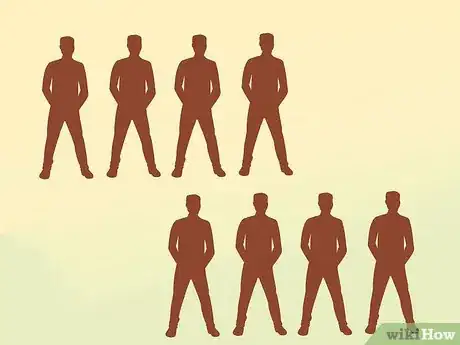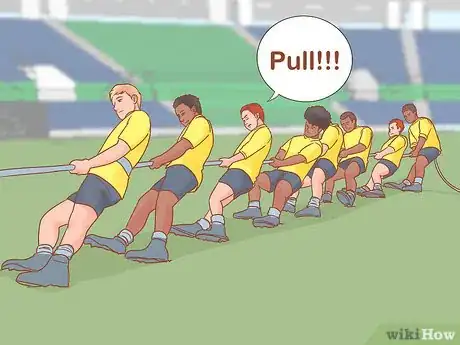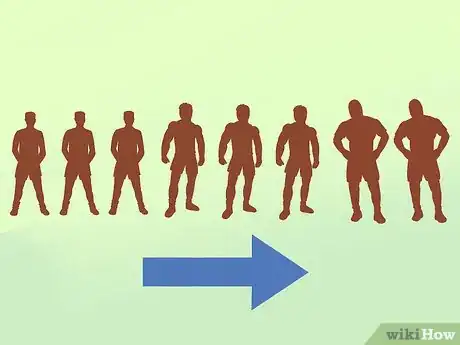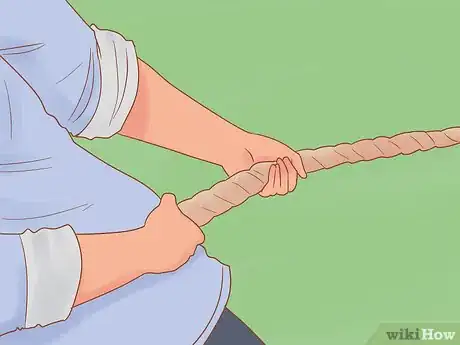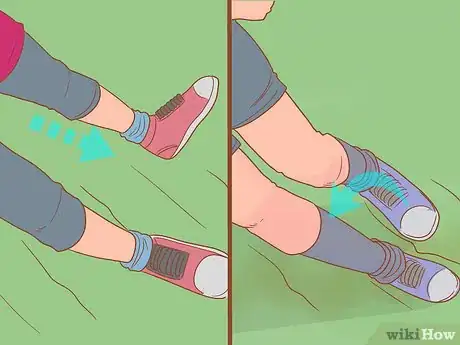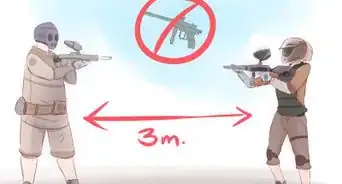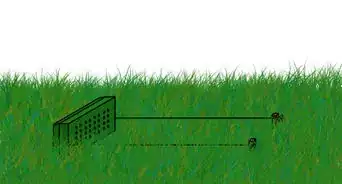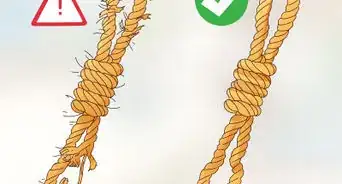This article was co-authored by wikiHow Staff. Our trained team of editors and researchers validate articles for accuracy and comprehensiveness. wikiHow's Content Management Team carefully monitors the work from our editorial staff to ensure that each article is backed by trusted research and meets our high quality standards.
wikiHow marks an article as reader-approved once it receives enough positive feedback. This article received 17 testimonials and 87% of readers who voted found it helpful, earning it our reader-approved status.
This article has been viewed 559,977 times.
Learn more...
Tug of war is a classic game that's frequently played at children's parties and family gatherings. In a game of tug of war, 2 teams stand at opposite ends of a rope and try to tug the rope until the majority of it is pulled over their side of the center line or marker. However, the game isn't as easy as it seems! There's plenty of strategy that goes into winning tug of war, and a lot of it has to do with the team's positioning and their technique.
Steps
Positioning the Team
-
1Gather 8 people of varying sizes and strength levels. The great thing about tug of war is that you can learn how to win as a team, even if you don't have the strongest people on your side! For organized leagues, you might also want to recruit 1-2 extra people as alternates in case someone gets hurt or has to miss a match.[1]
- If you're planning to play in a league, make sure the combined weight of the people on your team is less than the stated rules, which can vary depending on the age group.
-
2Place a more experienced team member at the front to lead the tug. This person will act as the “leader” of the group. Choose someone who is a medium height for the team and has played tug of war before. This person should be able to keep a good grip on the rope while in a squatting position and have a lot of lower body strength to keep the front of the line from becoming too strained.[2]
- It might be helpful to have the teammates stand from tallest to shortest and then pick one of the people close to the middle to be the lead tugger.
Advertisement -
3Stagger the middle teammates based on their skills to encourage teamwork. Position a less experienced member in between 2 more experienced members of the team so they can communicate throughout the game. That way, the knowledgeable teammates can set the pace of the tug and less experienced teammates can work on building up endurance and strength.[3]
- Talking and communicating throughout the game can be helpful for some members, but remember not to give away your strategy to the other team!
-
4Position someone with good endurance at the back of the team. Choose someone with good lower body strength and put them at the end of the rope so they can “anchor” the team. Make sure they're strong enough to continually pull the team back while maintaining a tight grip on the rope.
- In general, the anchor normally wraps the rope around their back and keeps the team moving backward.
- Normally, the anchor will set the pace for the tugging by taking a step back every 3-4 seconds. If the rest of the team can't keep up, it's up to the anchor to keep their grip and slow down so the rest of the team can reposition themselves.
Tip: Try putting your heaviest teammate at the back of the rope as the anchor. They can help pull the rest of the team backward when they lean back.
Perfecting Your Technique
-
1Grip the rope firmly with your palms up and hands positioned close together. Stand on the left side of the rope and pick up the rope with your right hand. Cradle the rope with your palm up, and place your left hand either right in front or right behind your right hand. Close your fist around the rope so that your thumbs are facing upward.
- Some sources recommend dusting your hands with chalk to help you grip the rope. This works well for some people, but you can still win without it!
Warning: Avoid wrapping the rope around your hands to grip it. While it may seem like a good idea, if the rope begins to slip, you can strain your wrists or break a bone.
-
2Squat and lean back to dig your heels into the ground when the whistle blows. When you line up for the game, position your feet so that they're about shoulder-width apart, and squat down so your knees are bent slightly. When the game begins, lean back at a 45-degree angle with your back straight to dig your heels into the ground and hold yourself in place. Don't pull or tug on the rope just yet, and instead let your weight do the work for you![4]
- If you bend your back or knees too much, you can cause unnecessary muscle strain, which can harm your endurance.
-
3Take small steps backward as a team, digging in with your heels. Before the match, talk to your teammates and plan to take a step back every 3-4 seconds, starting with your left foot. When the game starts, carefully lift and plant your left heel about 1–2 inches (2.5–5.1 cm) behind where it began. Then, repeat this with the right heel to slowly move backward, moving the other team. If you can, try taking larger steps as the opposing team begins to get tired.[5]
- You shouldn't be pulling or tugging on the rope. Instead, just hold it tightly and keep it close to your body as you move back.
- You can talk to the player in front of you and listen to the player behind you throughout the game. However, avoid saying things like “pull” or “move back” during the game, as the other team might hear you and have time to get into a better position.
-
4Keep your left leg straight and push off of it as you move back to counterattack. If you're losing your footing, try turning your body toward the rope on your right side to set up a counterattack move. Dig your left foot into the ground horizontally to slow any forward movement, and push off of it to propel your body backward. Shuffle your feet back 1 inch (2.5 cm) at a time as you push yourself backward.
- If you can't pull back, just try to stay in place until the other team gets too tired to keep pulling. Then, it might be easier to start moving again.
Strength-Building Exercises
Community Q&A
-
QuestionWould it be effective to line people up according to height?
 Community AnswerNot really, as height doesn't signify strength. It might look good, but what if the tallest person is also the weakest?
Community AnswerNot really, as height doesn't signify strength. It might look good, but what if the tallest person is also the weakest? -
QuestionIf I'm a fast runner, where should I position myself in tug of war?
 Community AnswerProbably towards the middle. Being a good runner won't help too much with tug of war since it's primarily about strength, but running does build strong leg muscles so you can use those to hold your rope steady.
Community AnswerProbably towards the middle. Being a good runner won't help too much with tug of war since it's primarily about strength, but running does build strong leg muscles so you can use those to hold your rope steady. -
QuestionWould it help if one person acted as the leader to call out the movements that should be worked together?
 Community AnswerYes. For example, the leader could count to three so that you all pull as hard as you can at the same time.
Community AnswerYes. For example, the leader could count to three so that you all pull as hard as you can at the same time.
Warnings
- Never wrap the rope around your hands to tug. This can cause you to strain your wrist or break a bone in your hand.⧼thumbs_response⧽
References
About This Article
To win at Tug of War, place an experienced team member with good lower body strength at the front of your group. Then, put your heaviest teammate or your teammate with the most endurance at the back of the group to serve as the anchor. Once the game starts, squat and lean back so your heels dig into the ground, which will help hold your team in place. Also, as the game progresses, take small steps back as a team. When the other team seems like they're getting tired, start taking larger steps back. To learn how to counterattack in Tug of War, scroll down!
